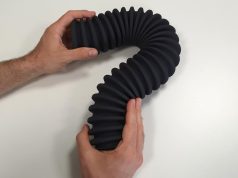Not so long ago breaking headlines in the medical industry were talking about the discovery of examining DNA to determine whether or not people are genetically predisposed to certain diseases and illnesses. Today, more and more headlines are shouting praise pertaining to the advances in rapid prototyping in the medical and healthcare industry. Everyday, a new advancement is made that is changing the face of medicine and giving more control to patients. However, as with all new technological advancements, the process is not without challenges yet the future success appears positively bright.
An Industry Transformation
The medical and healthcare industry is one of constant technological evolution that continues to surpass the imaginations of even some of the greatest innovative minds. Today, rapid prototyping through 3D printing is transforming the industry yet again. The healthcare is a controversial topic in many countries, and these advancements could very well provide everyone with affordable healthcare solutions despite economic status or a national healthcare program. Everyone could very well have a greater opportunity at equal medical assistance with rapid prototyping in medicine.
Advancements Include:
- body parts
- bioprinted blood vessels
- low-cost prosthetics
- drugs
- electrical sensors
- medical model replicas for research
- bone scaffolds
- heart valves
- ear cartilage
- medical equipment
- synthetic skin
- cranium implants
- organs
The advancements made in rapid prototyping within the medical industry are only the beginning. The cost of medical rapid prototyping is drastically reducing each year which is making this alternative form of medicine much more appealing and affordable to more people on a larger scale across the world. This process is, and will be, used in place of more expensive surgical procedures and materials, thus allowing more people in the world to have an opportunity to access top medical care that would normally never be available to them. With each passing day, medical 3D printing is transforming the entire medical and healthcare industry.

Medical Benefits
The benefits are proving to be nearly endless. One of such benefits is that It has been demonstrated that cells can be printed. The enormous benefits to this is that medical research can be conducted on these cells without having to use animals or humans. It has also been proven that children, who are constantly growing and their bodies changing, can more easily receive replacement parts and it is significantly more cost effective than previous methodologies, treatment plans, and medical materials.
Perhaps one of the greatest benefits of all to organ prototyping will be the elimination of the need for organ donors and dangerous black market transplant sales and operations. Organs are big business in the black market and on the dark web. The introduction of transplantable printed organs will save thousands of lives a year in both illegal activity and those waiting at home and in hospitals for an organ that never comes before it is too late. These prototyped organs will potentially make the entireorgan transplant system safer and available to all.
Obstacles
One of the biggest challenges and frustrations of medical professionals and patients alike is that bodies sometimes reject these fabricated materials. As these items are foreign substances that are not naturally found in the body, and even some that are, does not always work successfully. Also, much of the advancements are not yet able to be used in actual medical procedures as they are still in research and development stages such as organ transplants. Another frustration is that the costs of the machines are still not affordable on a global scale which is limiting the number of people with direct access to these medical marvels. However, it should be noted that this may not be a frustration for much longer.
Breakthrough
Two of the most optimistic ways in which the industry isovercoming the existing obstacles are through advances in the materials used to create the products and to outsource production to minimize costs.  It is the hope and belief of medical professionals and scientists that as the selection of materials used in the rapid prototyping process increases, the body rejection level will decrease significantly. And, rather than for medical facilities and hospitals to purchase their own medical 3D printers, they can outsource prototyping to companies that specialize in this area as a way to save money and minimize the capital required to produce these life-changing parts and pieces. These savings can then be passed along to patients. Ronan Ye, Managing Director at 3E Rapid Prototyping has been seeing this trend too, “Yes, we have been receiving more and more requests for medical device prototypes as of recent. It’s such a promising market with so much potential.”
It is the hope and belief of medical professionals and scientists that as the selection of materials used in the rapid prototyping process increases, the body rejection level will decrease significantly. And, rather than for medical facilities and hospitals to purchase their own medical 3D printers, they can outsource prototyping to companies that specialize in this area as a way to save money and minimize the capital required to produce these life-changing parts and pieces. These savings can then be passed along to patients. Ronan Ye, Managing Director at 3E Rapid Prototyping has been seeing this trend too, “Yes, we have been receiving more and more requests for medical device prototypes as of recent. It’s such a promising market with so much potential.”
Promising Future
The future of rapid prototyping in medicine is strong and positive. Lives will be saved, health care expenses will be lowered, and the quality of life for its recipients will increase. Whether someone is missing a limb from an act of war or someone was born with a heart defect, medical 3D printing is transforming the way people are cared for and more people will have a chance at a better life than ever before.
Resources:
- http://www.dezeen.com/2013/05/19/3d-printing-organs-medicine-print-shift/
- http://betanews.com/2015/05/29/the-benefits-of-3d-printing-in-healthcare/
- http://3dprintingindustry.com/2015/02/26/12-things-we-can-3d-print-in-medicine-right-now/
- http://www.emeraldinsight.com/doi/abs/10.1108/RPJ-07-2012-0065?journalCode=rpj
- http://www.healthwareinternational.com/blogpost/how-can-3d-printing-revolutionize-healthcare-411
- http://www.huffingtonpost.com/peter-mellgard/medical-3d-printing-future_b_7088994.html
Subscribe to our Newsletter
3DPResso is a weekly newsletter that links to the most exciting global stories from the 3D printing and additive manufacturing industry.
























